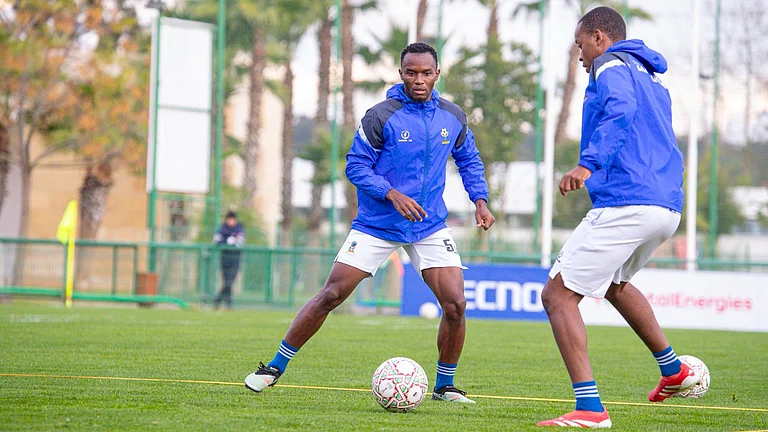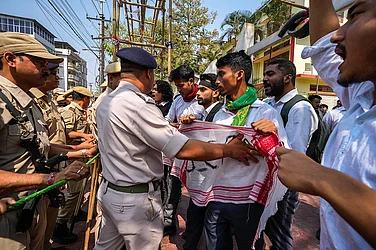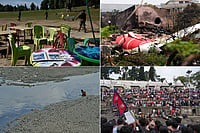Like “The Great Resignation” trend in the west that saw many mid-career professionals resigning after Covid-19, a very dramatic, though unrelated “resignation” trend is going on in UP Vidhan Sabha. Three ministers – Dharam Singh Saini, Swami Prasad Maurya, Dara Singh Chauhan and around a dozen MLA have resigned from BJP. Many of them have joined Samajwadi Party (SP).
“The Great Resignation” of UP has set an interesting stage, that some say is a resurgence of “Mandal – Caste based identity politics” vs “Kamandal" – mixing the caste identity politics in Hindutva project.
”Akhilesh Yadav has realised that he can’t defeat BJP, unless it has the support of non-Yadav backward castes – bringing small scale “Mandal Parties” in their fold would give a big social boost to SP.
Mulayam Singh was known for his outreach with non-Yadav OBC castes. He has representation from every caste in SP. But it struggled between 2012-17 to retain that leadership. Now again, Akhilesh is mobilising leadership from non-Yadav OBC and MBC to fight BJP by pitting politics of Mandal against BJP’s politics of Kamandal.
It all came into notice with the support of Suheldev Bhartiya Samaj Party (SPSP) chief Om Prakash Rajbhar to SP. Rajbhars has around 18 percent votes in Purvanchal region. In districts like Ghazipur, Mau, Varanasi, Ballia, Maharajganj and Shrawasti, Ambedkarnagar, Bahraich and Chandauli, Rajbhar’s support is critical. The support of “Mahan Dal” led by Keshav Dev Maurya was also interesting. Mahan Dal claims support from Shakyas, Mauryas, Sainis and Kushwahas communities in western UP.
So now, SP has formed alliance with seven regional parties – The Rashtriya Lok Dal (RLD), Mahan Dal, Janwadi Party (Socialist), Apna Dal faction led by Krishna Patel, Suheldev Bhartiya Samaj Party, Akhilesh’s uncle Shivpal Yadav's Pragatisheel Samajwadi Party and Gondwana Gantantra Party. All these parties have support within their respective caste community and above that too.
Apart from the above mentioned more visible small-scale caste-based parties, many Most Backward Communities like Bind, Gadariya, Nishad, Prajapati, Saithwar, Teli, Sahu, Hahar, Kashyap, Kachhi, Nai, Badhayi, Panchal, Dhiman, Loniya, Noniya, Gole Thakur, Loniya Chauhan, Murao, Fakir, Lohar, Koeri, Mali, Saini, Bharbhuja, Turaha and others have also an assertive leadership, which can turn election into anybody’s side. Because visibility and representation of a leadership from a caste doesn’t mean that less represented castes are electorally irrelevant.
Beside all that, a 2018-leaked report recommending Sub-categorisation of OBC castes was a hot topic in this election. But, now that has been sidelined. Badri Narayan, professor, Govind Ballabh Pant Social Science Institute, Allahabad said, “this is not a big discourse now. Because if it was implemented it would have disappointed Dominant castes.”
Among many other recommendations of this report, one was to restrict the reservation for “dominant castes” in OBC – Kurmis, Jat and Yadavs to 7 percent. Kurmis who have their own party, Apna Dal, and had supported BJP in the last election. A lot of Kurmi leadership in BJP seems to be breaking its ties with BJP. RLD, a Jat party has also tendered support to SP. RLD is now also focusing on Jat- Muslim unity in western UP.
Narayan said, “Om Prakash Rajbhar wanted to get that report implemented. His main discontentment is that. Had it been implemented it would have made the educated class of castes like Rajbhars, Nishads, Gadariya happy.”
This also suggests how “Kamandal politics”, introduced by Former Chief minister of UP Kalyan Singh, much before Narendra Modi’s brand of Hindutva politics is facing a stiff challenge from Mandal Politics. Because BJP, a flagbearer of Kamandal politics is itself involved in “Mandal Politics.” It has formed a caste coalition with nine caste- based small parties of “Hissedari Morcha”, a counter to the OP Rajbhar led “Bhagidari Morcha”.
Hissedari Morcha led by Kewat Ramdhani Bind has parties like Bharatiya Manav Samaj Party, Shoshit Samaj Party, Bharatiya Suheldev Janata Party, Bharatiya Samata Samaj Party, Manavhit Party, Prithviraj Janshakti Party, and Musahar Andolan Manch aka Gareeb Party.
However, support from a caste- based party doesn’t mean it will ensure full political support from that caste. Narayan in his Book “Republic in Hindutva” writes that there is competing leadership among each caste. If a leader amasses wealth and power — a competing leadership challenging the authority of that leader also emerges.
For instance, there is not just one Rajbhar leader, there are other Rajbhar MLAs in BJP. UP deputy CM Keshav Prasad Maurya too represents an MBC, Maurya caste. Which poses a challenge to the leadership of Keshav dev Maurya of Mahan Dal.
Moreover, “personal interests also make a caste leader irrelevant within their community” says Narayan. So, expecting them to bring all votes from a particular caste is foolish.
However, another major issue around which the current mobilisation of Most Backwards communities happened is “caste census”. These politically active castes want to know their exact number. Akhilesh has also promised that he will conduct a caste census, if voted to power. “Government is counting trees, animals. Why not backward castes. I want that caste census to be done, so that backwards can get benefits as per their share in population.” But this issue doesn’t seem to be used for mobilising voters on ground.
Interestingly, Bahujan Samaj Party (BSP) is being ignored in this election. But, Narayan believes, “BSP is still a very relevant third player.” BSP had mobilised Bahujan votes very well from the time of Kanshi Ram. Main wheel remained Jatav, along with votes from other Bahujan castes which Narayan calls, “Stepney votes”. But now, that has dwindled. A lot of these votes have gone to BJP. “There are more than 50 castes of Dalits in UP. Kanshi Ram used to say, “vote matt becho” (don’t sell votes), so many used to vote BSP. Now these castes think of long-term benefits, like if a school is built in their area.” Said Narayan.
Moreover, a perception that Brahmins are unhappy with Yogi Adityanath has also been given a weight by many Brahmin leaders like Satish Chandra Mishra of BSP. Yogi was accused of promoting “Thakurvaad”, a term referring to dominance “Kshatriya caste”, which has upset Brahmin (at least a perception is there), who wield a lot power due to their place in caste hierarchy.
The BJP is taking this perception seriously and attempting to counter it by reaching out to Brahmins from its cadres.
Also “Hindutva politics” is also being used from time to time. His recent “80 percent vs 20” percent jibe is an example of it. Clarifying 80 vs 20 Yogi Adityanath said, “20 per cent are those people who oppose Ram Janmabhoomi, Kashi Vishwanath dham, grand development Mathura Vrindavan. The 20 per cent are those who sympathise with mafias and terrorists.”
As political pundits say, “politics is a game of perceptions”. Everyone is doing their best to build a perception and sustain it. With time, it will become clearer how caste politics play out.





















